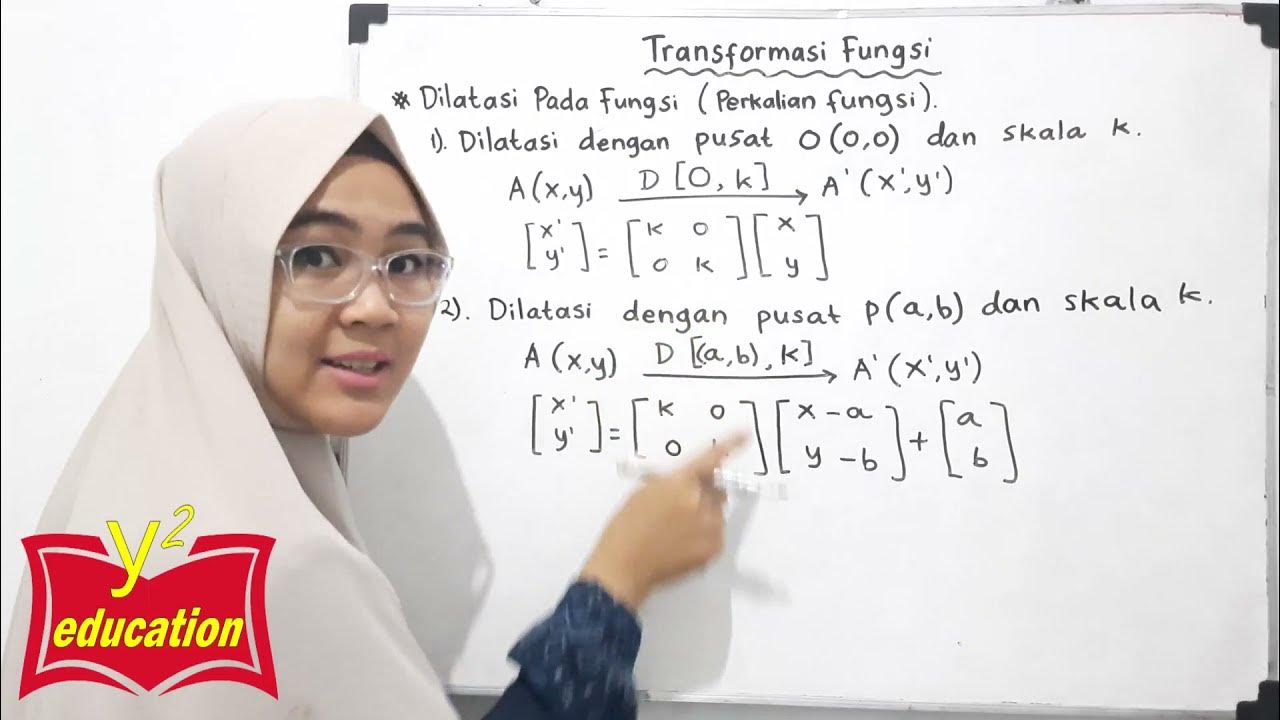Thinking about dilations | Transformations | Geometry | Khan Academy
Summary
TLDRThis script demonstrates a geometric dilation of rectangle ABCP with the center at point P and a scale factor of 1 and 2/3. It explains how to find the image of the rectangle by calculating the new positions of points A, B, and C based on the scale factor. The script concludes with the lengths of side AB and its dilated image, showing a clear step-by-step process that results in AB being 6 units and its image 10 units long.
Takeaways
- 📐 The script discusses a geometric transformation involving a rectangle ABCP and a dilation centered at point P.
- 🔍 The dilation has a scale factor of 1 and 2/3, which means every point will be 1 and 2/3 times as far from P after the transformation.
- 📍 Point P remains at the same position since it is the center of the dilation.
- 📏 Point C's new position is calculated by multiplying its distance from P by the scale factor, resulting in a new y-coordinate of -7.
- 📐 The horizontal distance from P to point A is multiplied by the scale factor, moving it 5 units away from P's x-coordinate.
- 📏 Point B's new position is determined by applying the scale factor to both its horizontal and vertical distances from P, resulting in a new x-coordinate 5 units away and a y-coordinate 10 units below P's y-coordinate.
- 📏 The original length of side AB is 6 units, calculated from the difference between the x-coordinates of points A and B.
- 📏 The length of the image of side AB after the dilation is 10 units, calculated from the new positions of the points.
- 🔢 The scale factor of 1 and 2/3 is equivalent to multiplying by 5/3, which is used to calculate the new positions of the points.
- 📈 The process involves understanding how a dilation affects the position and distances of points in a geometric figure.
- 📚 The script serves as an educational resource for understanding geometric transformations such as dilations.
Q & A
What is the process described in the transcript?
-The process described is a geometric transformation known as a dilation of a rectangle ABCP, with the center of dilation at point P and a scale factor of 1 and 2/3.
What is the scale factor used in the dilation?
-The scale factor used in the dilation is 1 and 2/3, which is equivalent to 5/3 when expressed as an improper fraction.
How does the dilation affect the distance of points from the center P?
-The dilation multiplies the distance of each point from the center P by the scale factor, making them 1 and 2/3 times as far away as they were originally.
What is the original position of point P in the dilation?
-Point P is the center of dilation, so its position remains unchanged during the dilation process.
What is the original distance of point C from point P?
-The original distance of point C from point P is 6 units, as it is 3 units below P's y-coordinate and 3 units to the left of P's x-coordinate.
How is the new position of point C calculated after the dilation?
-The new position of point C is calculated by multiplying its original distance from P by the scale factor and adjusting the coordinates accordingly, resulting in point C being at (-3, -7).
What is the original length of side AB of the rectangle?
-The original length of side AB is 6 units, as it is the horizontal distance between points A and B, which are 3 units away from P in opposite directions.
What is the length of the image of side AB after the dilation?
-The length of the image of side AB after the dilation is 10 units, as it is calculated by multiplying the original length by the scale factor.
How is the new position of point A calculated after the dilation?
-The new position of point A is calculated by multiplying its original horizontal distance from P by the scale factor, resulting in a new x-coordinate of 5 units to the right of P.
What is the significance of the dilation in geometric transformations?
-Dilation is significant in geometric transformations as it allows for the enlargement or reduction of a shape while maintaining its proportions, with all points being scaled by the same factor from a central point.
What is the relationship between the original and the image of side AB in terms of length?
-The length of the image of side AB is 1 and 2/3 times the length of the original side AB, demonstrating the effect of the dilation on the dimensions of the shape.
Outlines

此内容仅限付费用户访问。 请升级后访问。
立即升级Mindmap

此内容仅限付费用户访问。 请升级后访问。
立即升级Keywords

此内容仅限付费用户访问。 请升级后访问。
立即升级Highlights

此内容仅限付费用户访问。 请升级后访问。
立即升级Transcripts

此内容仅限付费用户访问。 请升级后访问。
立即升级浏览更多相关视频

(LENGKAP) TRANSFORMASI GEOMETRI - Translasi, Refleksi, Rotasi dan Dilatasi

Transformasi Geometri Bagian 4 - Dilatasi (Perkalian) Matematika Wajib Kelas 11

DILATASI (PERKALIAN) || TRANSFORMASI GEOMETRI

Transformasi Fungsi #Part 2// Dilatasi Fungsi // Perubahan Grafik Fungsi Akibat Dilatasi/Perkalian

Enlargements - Corbettmaths

PATOGE (Papan Transformasi Grometri)
5.0 / 5 (0 votes)
